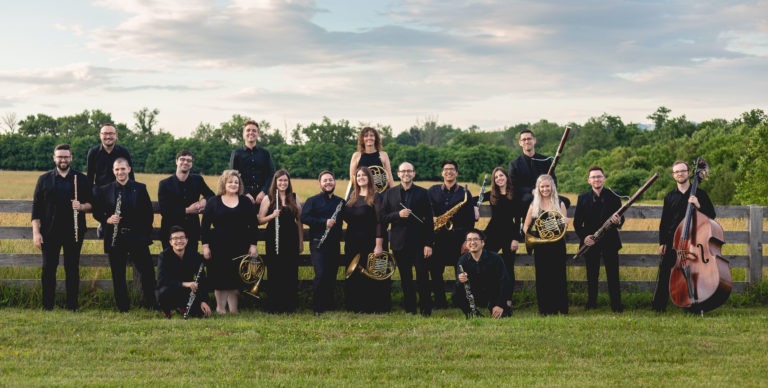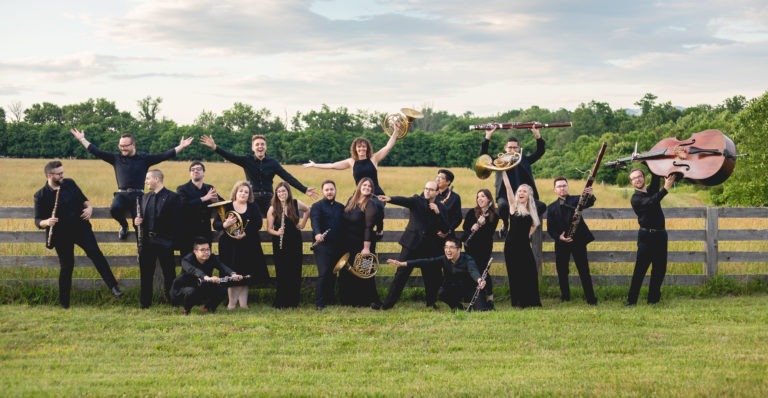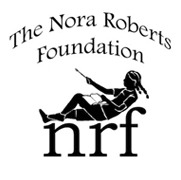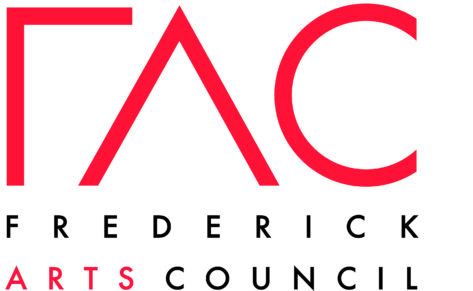2022 Maryland Wind Festival
Digital Program
Trinity Lutheran Church
June 17, 2022 | 7:00 PM
Maryland Chamber Winds
Tyler Austin, Artistic Director
and Conductor

Program
Overture to ‘L’Amant Anonyme’
Joseph Bologne, Chevalier de Saint-Georges, arr. Derek Stoughton
Three Songs from ‘Des Knaben Wunderhorn’
I.Rheinlegenchen
II. Wer hat dies Liedel erdacht?
III. Lob des hohen Verstandes
Gustav Mahler, arr. Trevor Cramer
Where the Colors Fall
Alyssa Morris
Consort for Ten Winds
I. Jeux
II. Aubade
III. Sautereau
Robert Spittal
INTERMISSION
Figures in the Garden
I. Dancing in the Dark
II. Susanna in the Rain
III. A Conversation
VI. Voices in the Garden
VII. Nocturne: Figaro & Susanna
Jonathan Dove
Divertissement, Op. 36
I. Andante – Allegro
II. Allegro Vivace
III. Andante – Allegro
Emile Bernard
Thank you for joining us this evening!
Keep the music alive – donate today!

Maryland Chamber Winds
Tyler Austin, Artistic Director & Conductor
Evan Harger, Associate Conductor
Yuji Jones, Education Coordinator
Flute
Matthew Angelo
Mary Matthews
Oboe
Matthew Hudgens
Andrew W. Parker
Clarinet
Cheyenne Cruz
Brian Do
Nick Thompson
Bassoon
Billy Beecher
Dillon Meacham
Midori Samson
Horn
Kelsey Bentley
Sean Donovan
Danielle Fisher
Rachel Hockenberry
Saxophone
Jeffrey Leung
Double Bass
Kimberly Parillo
2022 Intern
Doug Bell
Click below for our musician's bios!

Program Notes
Overture to 'L'Amant Anonyme' - Joseph Bologne, Chevalier de Saint-Georges, arr. Derek Stoughton
Joseph Bologne, Chevalier de Saint-Georges (1745-1799) has possibly the most fascinating life story in all of classical music. ‘The Chevalier’ was born Joseph Bologne on the French Caribbean island of Guadeloupe in 1745. His father, Georges Bologne, was a minor French nobleman and plantation owner there; his mother, Anne, was a young enslaved Black woman of Senegalese descent. France’s “Black Laws” forbade his parents to marry and prevented Joseph from inheriting his father’s title, but the young man was raised as a gentleman and mastered the arts of swordsmanship and horsemanship. He gained his first fame as a fencer, defeating some of France’s most celebrated swordsmen while still just a teenager. Louis XV became such an admirer that in 1766 he made the young man an officer of the Royal Bodyguard and bestowed on him the honorific “Chevalier de Saint-Georges.”
Remarkably, while at military school, Joseph managed to become a virtuoso violinist. He created a sensation three years later when he first appeared as a soloist with the orchestra. The next year he assumed leadership of the orchestra, and when in 1776 a new director of the Paris Opera was needed, St.-Georges was the obvious choice.
St.-Georges’ music epitomizes the gentlemanly virtue of bonne grace. Understated and deceptively simple, it piques the interest not with the emotionality of Mozart or the rhythmic gamesmanship of Haydn but with smaller, subtler virtues: a surprising melodic leap here, an unexpected turn of phrase there. L’amant anonyme, a comic opera with ballet, premiered in 1780; it’s the only one of his six operas which survives in its entirety. Its three-part, fast-slow-fast overture reflects the love triangle at the center of its plot; its oscillation between major and minor mode reflects the story’s secret-admirer ambiguities. Here, as he did in all those duels, St.-Georges makes it look easy.
Maryland Chamber Winds would like to wholeheartedly thank Derek Stoughton for creating this beautiful arrangement.
Three Songs from 'Des Knaben Wunderhorn' - Gustav Mahler, arr. Trevor Cramer
Clemens Brentano and Achim von Arnim met in 1801 as students at the University of Göttingen, and the following June they took a boat trip together down the Rhine. Romantic aesthetics had recently begun to dominate the literary world, which was accordingly swept up in such fascinations as folk legend, a nostalgic longing for the Middle Ages, and the awe and mysteries of nature. In 1805 Brentano and von Arnim added to the Romantic bookshelf with a volume of their own, the first of what would eventually be three installments titled Des Knaben Wunderhorn (The Boy’s Magic Horn), a compendium of about a thousand poems.
Mahler incorporated texts from this collection into movements of his Second, Third, and Fourth symphonies. But he also composed independent song settings from Des Knaben Wunderhorn with piano accompaniments, others with chamber orchestra. This version has been arranged by Trevor Cramer for Reed Quintet.
No Maher aficionado would have trouble relating these songs to what many of us cherish most in his symphonies: their tendency to turn on a dime, to shift instantly from one emotional state to an entirely different one, to expose states of mind or soul in highlighted relief rather than settle into the becalmed doldrums of an emotional middle-ground. This arrangement features three songs from the cycle; Rheinlegendchen (Little Rhine Legend), Wer hat dies Liedlein erdacht? (Who Thought Up This Song?), and Lob des hohen Verstandes (Praise of Lofty Intellect).
Where the Colors Fall - Alyssa Morris
Ensign Peak is best described as an “undistinguished hill, rising over a thousand feet from the northern edge of [Utah’s] Salt Lake Valley… “It does not stand out in the aesthetic ways that many nearby peaks of the Wasatch range stand out. The attention Ensign Peak receives comes from its historical significance.”
This dectet, “Where the Colors Fall,” has been created by deconstructing the hymn “High on a Mountain Top” (words by Ebenezer Beasley and music by Joel H. Johnson.) The words to the hymn are as follows:
High on the mountain top
A banner is unfurled.
Ye nations, now look up;
It waves to all the world.
In Deseret’s sweet, peaceful land,
On Zion’s mount behold it stand!
For God remembers still
His promise made of old
That he on Zion’s hill
Truth’s standard would unfold!
Her light should there attract the gaze
Of all the world in latter days.
His house shall there be reared,
His glory to display,
And people shall be heard
In distant lands to say:
We’ll now go up and serve the lord,
Obey his truth and learn his word.
For there we shall be taught
The law that will go forth,
With truth and wisdom fraught,
To govern all the earth.
Forever there his ways we’ll tread,
And save ourselves with all our dead.
This hymn describes Ensign Peak, “..,.the point where the colors fall.” It is the composer’s hope that this dectet will illuminate the beautiful colors that can be found in this instrumentation, and that the work will pay tribute to the many sacrifices my own ancestors, and many of yours, made to get to “…the point where the colors fall.”
Consort for Ten Winds - Robert Spittal
Robert Spittal is an American conductor and composer who serves as Associate Professor of Music and Director of Winds and Percussion at Gonzaga University in Spokane, Washington. He conducts the Wind Symphony and Chamber Wind Ensemble. Spittal developed his interest in wind music after studying conducting with Craig Kirchhoff at The Ohio State University. He went on to study with Michael Haithcock and Eugene Corporon, to whom Consort for Ten Winds is dedicated, and received the doctor of musical arts degree in 1995.
The composer writes about this piece:
“Each movement of Consort acknowledges “Les Grandes Hautboise,” the court wind band of France’s great “Sun King,” Louis XIV. This court was seen throughout Europe as the most resplendent of its time, and the presence of a court wind band there encouraged other courts in Europe to imitate and establish their own wind bands. This system of patronage continued to develop through the classical era, mostly in Germany, Austria and Czechoslovakia, resulting in notable wind ensemble pieces by composers such as Mozart, Haydn, and Beethoven. Despite the decline of court music in the early 19th century, 19th- and 20th-century composers, most notably Dvorak, Strauss and Stravinsky, continued to pay homage to the harmonie tradition.
Consort is this composer’s attempt to pay homage to the origins of that tradition. The outer movements Jeux (games) and Sautereau (a French saltarello) are whimsical, lively dances which reflect the frivolities and excesses of the court. They also refer to the importance of dance at the French court. The court’s composer, and founder of “Les Grandes Hautboise,” Jean-Baptiste Lully, established France’s first ballet academy during his tenure. The middle movement Aubade (morning song) is more intimate, lyrical, and influenced by the imitative styles of vocal music of the period.
All musical materials in this work are original, and not based on any specific pieces of that period. Rather, this is contemporary music that acknowledges the prevailing influences of music from an earlier time.”
Figures in the Garden - Jonathan Dove
Few composers working today have embraced the modern opera house as consistently and successfully as Jonathan Dove. His incomparable catalogue of more than twenty diverse operatic works is indicative of a practical and lively theatrical mind, steeped in operatic experience. In all his music, Dove has a strong desire to communicate, to entertain, and to provoke transformative experiences. Outside of the concert hall and opera house, Dove has provided many scores for major theatrical productions. He is an Associate of the National Theatre (most recently providing music for His Dark Materials and Oedipus), and for many years was Music Advisor to the Almeida Theatre. He has also written for the Royal Shakespeare Company, and for the New York Shakespeare Festival.
About Figures in the Garden, Dove writes:
“For their 1991 Mozart bicentenary celebrations, Glyndebourne commissioned five composers to write wind serenades. Each serenade was to be musically connected in some way with one Mozart’s operas, and to be played outdoors before the performance of the opera. I was asked to compose a piece to precede The Marriage of Figaro.
Although Mozart’s comic masterpiece needs no introduction, musically or otherwise, I was attracted by the aptness of playing a serenade in the garden before performances of an opera whose last act is set in a garden, and which itself includes a number of serenades: Voi che sapete, Deh vieni, non tardar, and Susanna and the Countess’ letter-writing duet Canzonetta sull’aria.
I had the idea that with all the performances of The Marriage of Figaro that had taken place at Glyndebourne, sounds from the opera had in some way impregnated the garden: snatches of recitative, musical figures, instrumental colours. I didn’t want to overwork Mozart’s tunes – it would be disastrous if the audience were tired of them before the opera had even begun – but each movement of Figures in the Garden is developed from a musical idea in the opera. Here and there an alternative scenario emerges: Susanna sings her aria in the rain (because it’s an English garden), and Figaro and Susanna finally enjoy a moment of shared tranquility that is denied them in the opera.”
Divertissement, Op. 36 - Emile Bernard
Jean Émile Auguste Bernard was a French Romantic composer and organist, born in Marseille and studied at the Paris Conservatoire. He was an organist at the Notre Dame des Champs from 1885 until his retirement. As a composer, he was the author of several symphonic and vocal works as well as piano and organ pieces. Although he has distinguished himself in the field of chamber music. He obtained the 1889 Chartier Institute Award for his production in this genre.
The French term divertissement (divertimento in Italian) was frequently used in the 18th and 19th century to identify an instrumental composition written in a light vein and used primarily for entertainment. The title was often given to an enormous variety of music written for chamber ensembles consisting of three to eight or more players. Closely related types are the serenade, cassation, and nocturne. Over the years, the divertimento has evolved into many different styles and forms.
Emile Bernard’s Divertissement, for example, is an outstanding three-movement wind symphony in a late Romantic style. Bernard was not a prolific composer. However, his serious and reflective disposition is shown in almost all of his works, including the Divertissement. Composed around 1894 for wind dectet and first performed and commissioned by the Parisian “Société de musique de chambre pour instruments à vent,” founded by Paul Taffanel some years before, in 1879. The writing is fresh, virtuosic, and has a delicious and charming effect.
Help MCW continue to serve the state of Maryland!





